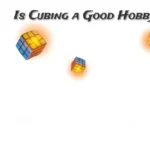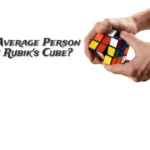The Rubik’s Cube, invented by Ernő Rubik in 1974, is a 3D mechanical puzzle consisting of a 3x3x3 grid of cubies that can be twisted and turned. The goal is to restore each face to a single color. The Rubik’s Cube is known for its immense number of possible combinations. The cube can be in approximately 43 quintillion (43,252,003,274,489,856,000) different configurations. This astronomical number arises from the numerous possibilities for arranging the cubies and the orientations of each cubie. God’s number refers to the minimum number of moves required to solve any scrambled Rubik’s Cube configuration. It represents the ultimate limit of complexity for solving the puzzle.
God’s number is a measure of the puzzle’s inherent complexity and serves as a benchmark for understanding the optimal solving strategies and algorithms. It represents the shortest possible solution for any configuration, revealing the underlying mathematical properties of Rubik’s Cube. This article explains the concept of God’s number and its significance in the world of Rubik’s Cube solving.
What Is God’s Number to Solve a Rubik’s Cube?
God’s number is the minimum number of moves required to solve any scrambled Rubik’s Cube configuration. It represents the ultimate limit of complexity for solving the puzzle. Determining God’s number is significant because it provides insights into the structure and mathematical properties of Rubik’s Cube. It is a benchmark for measuring the efficiency of solving algorithms and techniques.
Since the invention of the Rubik’s Cube, mathematicians, computer scientists, and enthusiasts have been intrigued by the quest to determine God’s number. In the early years, researchers used exhaustive computer searches to find the shortest solutions for specific cube configurations. These efforts gradually led to the discovery of lower bounds for God’s number. In 1995, Michael Reid published a groundbreaking result, proving that God’s number to solve a Rubik’s cube is at most 20. This upper bound remained unchallenged for over two decades until significant advancements were made in the field.
Different mathematical and algorithmic approaches used in the search for God’s number
The search for God’s number involves a combination of mathematical and algorithmic approaches. Group theory, combinatorics, and mathematical analysis are utilized to explore the mathematical properties of Rubik’s Cube configurations. Additionally, advanced algorithms, such as the IDA* search algorithm and the Kociemba algorithm, have been developed to efficiently navigate through the vast number of cube configurations.
Computer-assisted searches and distributed computing projects have played a vital role in exploring Rubik’s Cube’s immense solution space. The combination of mathematical analysis and algorithmic exploration has helped researchers uncover new lower and upper bounds for God’s number.
The quest for God’s number continues, with ongoing research and collaborations pushing the boundaries of knowledge in solving the Rubik’s Cube. By employing mathematical insights and innovative algorithmic techniques, researchers strive to determine the exact value of God’s number and gain a deeper understanding of the puzzle’s intricacies.
Discovery of God’s Number in Rubik’s cube
In order to quest to determine God’s number, significant milestones have been achieved over the years. These milestones represent advancements in finding lower and upper bounds for the minimum number of moves required to solve any Rubik’s Cube configuration. Some notable milestones include:
- 1981: Morwen Thistlethwaite established an upper bound of 52 moves for God’s number, reducing the initial estimate of 100 moves.
- 1995: Michael Reid proved that God’s number is at most 20, significantly reducing the upper bound and indicating that solving the Rubik’s Cube requires no more than 20 moves.
- 2005: Silviu Radu demonstrated a specific configuration that requires at least 26 moves, providing a lower bound for God’s number.
Current known lower and upper bounds for God’s number:
The current known lower and upper bounds for God’s number are:
- Lower bound: The current lower bound is 26 moves, which was proven by Silviu Radu in 2005. It means that at least one scrambled configuration exists that requires a minimum of 26 moves to solve.
- Upper bound: The current upper bound for God’s number is 20 moves, as proven by Michael Reid in 1995. This indicates that no matter the scrambled configuration, it can be solved within 20 moves or fewer.
Methodology used in reaching these bounds:
The discovery of lower and upper bounds for God’s number involved a combination of mathematical analysis, computer-assisted searches, and algorithmic exploration. Researchers employ sophisticated algorithms and powerful computing resources to explore the immense solution space of Rubik’s Cube.
To establish lower bounds, researchers focus on finding specific cube configurations that require a minimum number of moves to solve. By demonstrating that a particular configuration cannot be solved in fewer moves, they establish a lower limit for God’s number.
Upper bounds are determined by conducting extensive computer searches and employing advanced mathematical techniques. Researchers use computer programs to analyze a vast number of cube configurations and generate optimal solutions. These solutions are then analyzed to determine the maximum number of moves that are required to solve any scrambled configuration, providing an upper bound for God’s number.
The methodology used in reaching these bounds combines mathematical reasoning, algorithmic exploration, and the power of modern computing to gain insights into the complexity of the Rubik’s Cube and approximate the elusive value of God’s number. Ongoing research and advancements in computing power continue to push the boundaries and refine our understanding of this puzzle’s ultimate solving limit.
Relationship between God’s number and the structure of the Rubik’s Cube group
The concept of God’s number is closely related to the mathematical structure of the Rubik’s Cube group. The Rubik’s Cube group represents all possible states and transformations of the puzzle. God’s number sheds light on the properties and complexity of this group. Studying God’s number helps researchers explore the properties of group theory, combinatorics, and mathematical symmetries within the Rubik’s Cube. By understanding the intricacies of the Rubik’s Cube group, researchers can deepen their knowledge of group theory and apply these principles to other mathematical and scientific domains.
The exploration of God’s number and its relationship to the Rubik’s Cube group is an ongoing endeavor, contributing to our understanding of the puzzle’s mathematical underpinnings and the broader field of group theory.
By delving into the insights from God’s number, we gain a deeper appreciation for the puzzle’s complexity, strive for more efficient solving algorithms, and uncover the intricate mathematical relationships within the Rubik’s Cube group. These insights propel further advancements in solving techniques and our understanding of mathematical structures.
Conclusion
God’s number holds immense significance in the world of Rubik’s Cube solving. It is a milestone in our understanding of the puzzle’s complexity and establishes an upper limit on the minimum number of moves required to solve any scrambled configuration. It is a benchmark for evaluating the efficiency of solving algorithms and encourages researchers to explore and develop faster methods. God’s number offers insights into the mathematical properties of the Rubik’s Cube group and contributes to the broader field of group theory. By unraveling the mystery of God’s number, we gain a deeper understanding of the Rubik’s Cube and the challenges it presents.
Remember, the Rubik’s Cube is not just a puzzle to be solved; it is a gateway to a world of exploration, innovation, and personal achievement. So, pick up your cube, embrace the challenge, and let your journey of Rubik’s Cube solving continue to unfold.




